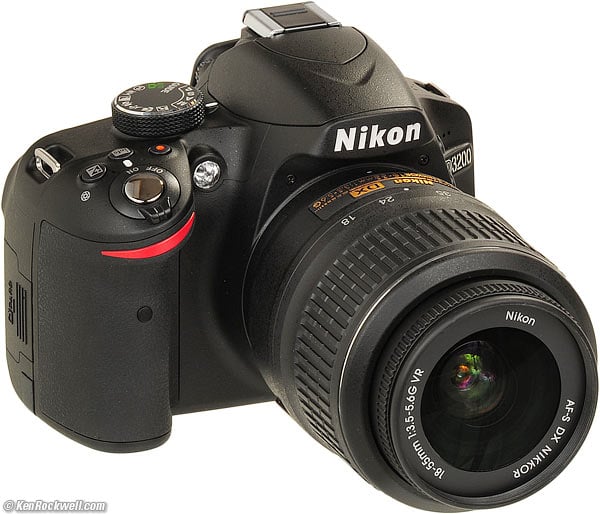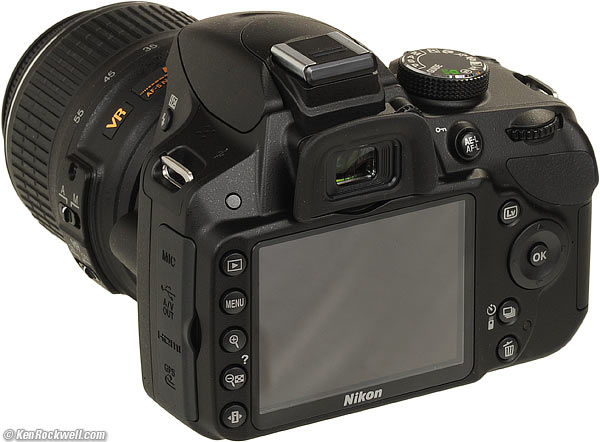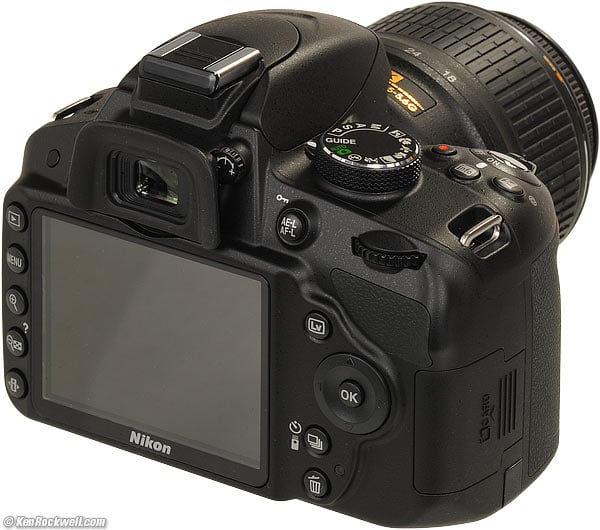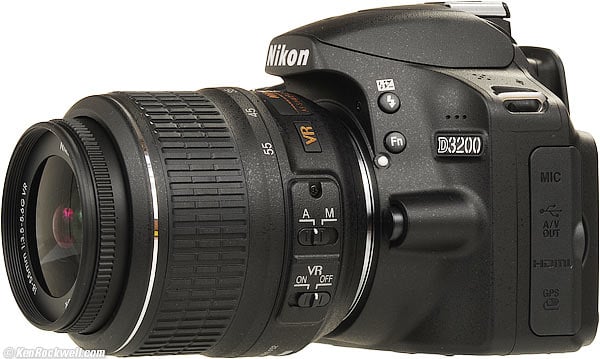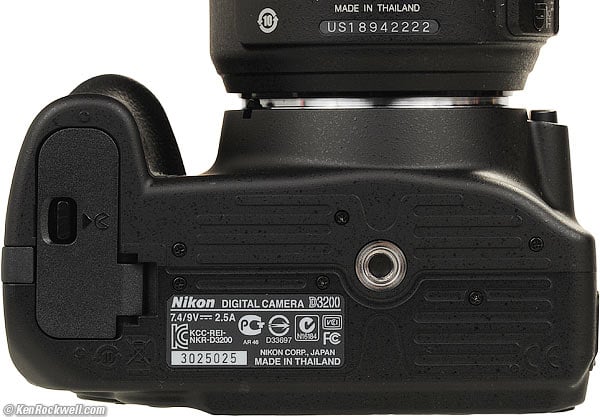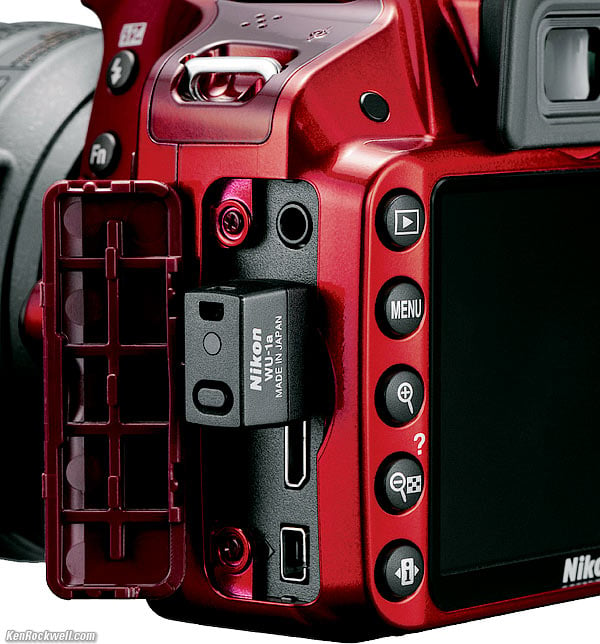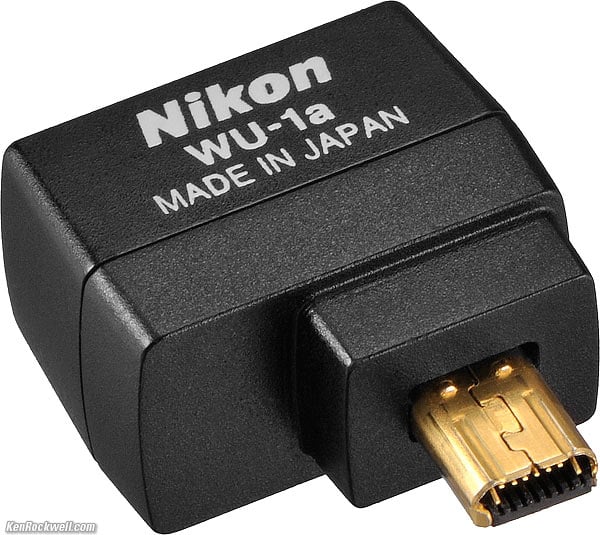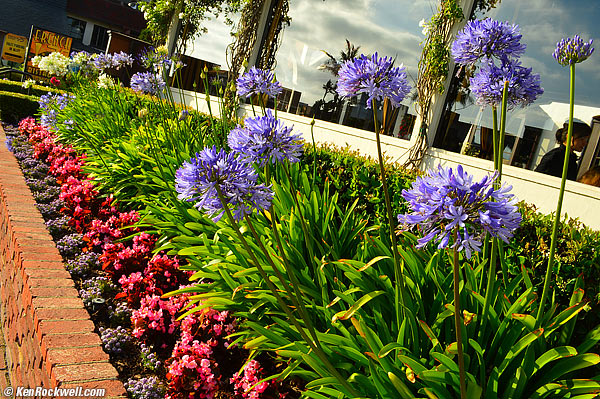Home Donate New Search Gallery Reviews How-To Books Links Workshops About Contact
Nikon D3200
24MP DX, 3" LCD, 4 FPS, 1080p
© KenRockwell.com. All Rights Reserved.
Intro Specs Performance Recommendations More
Nikon D3200 with included 18-55mm VR lens. (26.9 oz./764g with lens, card and battery, 17.6 oz./498g body-only with card and battery, about $200 with lens or $150 without if you know How to Win at eBay or about $285 used through Amazon (also in red).
My biggest source of support for this free website is when you use those or any of these links when you get anything, regardless of the country in which you live. It helps me keep adding to this free website when you get your things through these links — but I receive nothing for my efforts if you buy elsewhere. Thanks for your support! Ken.
Top, Nikon D3200. enlarge.
Back, Nikon D3200. enlarge.
Nikon D3200. enlarge.
Nikon D3200. enlarge.
Nikon D3200. enlarge.
Bottom, Nikon D3200. enlarge.
Also comes in red, shown with a 55-200mm VR. enlarge.
July 2012 More Nikon Reviews Nikon Lenses All Reviews
NEW: Nikon D3300. The newest 2014 model.
Introduction top
Intro Specs Performance Recommendations More
|
Adorama pays top dollar for your used gear. I use these stores. I can't vouch for ads below.
|
The Nikon D3200 is Nikon's newest replacement for their least expensive DSLR, 2010's D3100, which was and still is a very good and inexpensive camera.
The Nikon D3200 is a wonderful camera for anything. The only reason to pay $6,000 for a Nikon D4 is if you're a full-time professional sports and action shooter.
The D3200 is small, light, and very quiet and refined. The D3200 is smaller and quieter than Nikon's more professional cameras, which is a huge help when shooting candidly.
While not as fast or as distracting as Nikon's professional cameras, the D3200 has as much or more resolution than any Nikon professional DSLR!
The D3200 has more than enough speed for chasing kids, school sports and theatre, and far more pixels than anyone will ever need.
You need a real DSLR like this to capture still photos of motion, sports, kids and action. Smaller non-DSLR cameras like micro 4/3, cell phones and point-and-shoots just can't focus as fast as a DSLR to follow all the action.
The D3200 is for people who want great pictures. More expensive cameras are for men who just want fancier cameras.
While I cover all the more expensive Nikons which are of interest to hard-core photographers, when my friends ask what camera to get, it's always this inexpensive D3200.
As of June 2012, this D3200 is brand new and not discounted. The fancier D5100 has been out longer so it sells for a little less, so if this is the case, by all means, get the D5100 instead. Avoid the awful old D3000 at any price, however the previous model D3100 is also a superb camera, and if you can find a new one at a low price, by all means, get the D3100 instead. 24 Megapixels is baloney; Nikon only added all the extra pixels to impress amateurs; no one needs any more than 3 to 6 megapixels for anything.
The D3200 is the first DSLR to have so much resolution that it actually has more resolution than the lens with which it ships. 24 Megapixels are more than anyone needs for anything. Personally, I set my D3200 down to its lowest resolution, 6 megapixels, for all my photos. 6 MP is more than enough for great 12 x 18" and 20 x 30" (50 x 75cm) prints, if you know what you're doing. If you don't know what you're doing, you'll get soft images regardless of what camera you use.
Unlike the earlier D3000, the D3200 has more than enough DSP (processing) power to pull off all of its tricks. Everything works fast.
All this DSP lets the D3200 process its high-ISO images and pull out the noise very well. My shots at ISO 6,400 look great. In fact, this great hyper-ISO ability lets one use the kit lens for just about anything in any light. I love my 35mm f/1.8 lens, but even with the slower kit lens there's no problem photographing in low light with no flash.
This new D3200 is marvelous because of its super light weight, just 17.8 oz./505g with battery and SD card, making it as light as the lightest Nikon DSLRs ever made. It's the same weight as the D3100, and lighter than the D40.
It adds a new MOVIE REC button near the shutter and a much higher-resolution but same-size 3" LCD as the D3100.
The D3200 has more resolution than any DX DSLR on Earth, or anything from Canon at any price, but no one cares anymore. 6 to 10 MP is more than enough for anything. North Coast Photo has a 40 x 60" (1 x 1.5 meter) print on display shot with a 6 MP Nikon D40, and it looks awesome. Walk in there some time and see for yourself. Sharp photos come from sharp photographers; the camera is irrelevant.
Lens Compatibility top
With no built-in AF motor or aperture feeler for manual-focus lenses, it only autofocuses with AF-S and older professional AF-I lenses, same as Nikon's other cheap DSLRs.
Older screw-type AF and AF-D (non AF-S) lenses expose and work perfectly otherwise, but you'll have to focus them by hand.
More at Nikon Lens Compatibility.
Specifications top
Intro Specs Performance Recommendations More
Sensor
24 MP DX (23.2 x 15.4 mm) CMOS.
6,016 × 4,000 pixels native (LARGE, 24MP).
4,512 × 3,000 (MEDIUM, 13.5MP).
3,008 × 2,000 (SMALL, 6MP).
White Balance modes: Auto, incandescent, fluorescent (7 types), direct sunlight, flash, cloudy, shade, preset manual, all except preset manual with fine-tuning.
Live View.
Sensor cleaner.
No crop modes.
ISO
100 ~ 6,400, expandable to ISO 12,800 (HI+1).
AUTO ISO.
AF top
11 points: Single-point AF, dynamic-area AF, auto-area AF, 3D-tracking (11 points).
AF-S (focus and lock), AF-C (continuous AF) and AF-A (automatic selection depending on if subject moves or not.)
Finder top
Lightweight pentamirror.
95% coverage.
0.80x magnification with 50mm lens (smaller than FX cameras because it's 80% of a smaller area).
18 mm eyepoint.
-1.7 to + 0.5 diopters.
Type B BriteView Clear Matte Mark VII screen.
Meter top
3D Color Matrix Meter II, 420 RGB pixels.
Center-weighted.
Spot on any of the 11 AF points.
i-TTL flash metering for use with SB-910, SB-900, SB-800, SB-700, SB-600 and SB-400.
Built-in Flash top
GN 39/12 (Feet/meters at ISO 100).
Does not control wireless flash, you'll have to buy the SU-800 to work as commander.
Shutter top
1/4,000 ~ 30 seconds in third-stop steps.
Bulb.
Time exposures with optional ML-L3 remote control.
Front and rear receivers for use with the optional ML-L3 remote control.
Flash Sync: 1/200.
Frame Rates top
4 FPS, in manual focus and at 1/250 second or faster.
Slower shutter speeds or expecting autofocus to focus for each frame will slow it down.
Picture Controls top
Standard Gen 2 Picture Controls (Standard, Neutral,Vivid, Monochrome, Portrait, Landscape).
You can modify them.
Video top
1080p video with claimed full time AF, but DSLR video AF systems never work well. DSLR video focus can't track motion, which is the whole point of video. For video, I use my iPod touch instead because it always tracks perfect focus.
ISO 200 - 12,800.
Manual exposure control and mono microphone. (Stereo microphone input jack.)
1080/29.97p.
1080/23.976p.
1080/25p.
720/59.94p.
720/50p.
(No 720/29.97p or 720/25p.)
640 × 424 @ 29.97p.
640 × 424 @ 25p.
High or Low compression.
H.264/MPEG-4 Advanced Video Coding.
Linear PCM audio.
.MOV file format.
HDMI (type C) and analog outputs.
Audio top
Built-in mono mic.
3.5mm stereo mic jack.
Manual or auto recording gain control.
Linear PCM only as part of video recording.
File Formats top
JPG, NEF, or NEF+JPG.
NEF (raw) in 12-bit compressed.
JPG in BASIC, NORMAL or FINE.
File Sizes top
20.4 MB NEF.
11.9 MB LARGE JPG FINE.
6.2 MB LARGE JPG NORMAL.
3.0 MB LARGE JPG BASIC.
1.9 MB MEDIUM JPG BASIC.
1.0 MB MEDIUM JPG BASIC.
Data Storage top
One SD, SDHC or SDXC card, 2 GB to at least 64 GB.
LCD top
Exquisite 3," 921,000 dots.
Data Communication top
USB.
HDMI, type-C connector.
Power top
EN-EL14 Li-ion battery: 7.4V 1,030 mAh, 7.7Wh.
Rated 540 shots, CIPA, which is 50% with flash.
MH-24 Battery Charger.
Size top
3.8 x 5.0 × 3.1 inches, HWD.
96 × 125 x 76.5 millimeters, HWD.
Weight top
17.550 oz./497.5g with card and battery (no lens), measured.
26.938 oz./763.65g with lens, card and battery, actual measured.
Nikon rates it at 17.8 oz. (505g) with battery and SD card.
Nikon rates it at 16.0 oz. (455g) stripped.
Quality top
Made in Thailand (camera and lens).
Battery cells made in China, and then assembled into batteries in Indonesia.
Charger made in China.
Environmental top
0 - 40ºC (32-104ºF) operating.
< 85% RH, no condensation.
Included top
D3200 body.
EN-EL14 Rechargeable Li-ion Battery
MH-24 Battery Charger
DK-5 Eyepiece Cap
DK-20 Rubber Eyecup
UC-E17 USB Cable
EG-CP14 Audio Video Cable
AN-DC3 Camera Strap
BF-1B Body Cap
BS-1 Accessory Shoe Cover
Nikon ViewNX 2 software CD-ROM
Announced top
19 April 2012.
Shipping since top
Late April 2012.
Price (USA) top
October 2012
$599 with 18-55mm VR lens.
July 2012
About $550 with lens at Adorama (also in red) and at Amazon (also in red).
Introduction, April 2012
$699.95 including 18-55mm VR lens.
Accessories top
ML-L3 remote control.
The WU-1a is hanging out the door.
Optional WU-1a Wireless Mobile Adapter ($59.95, late May 2012) works only with Android doo-dads, making it useless for most of us.
If you get it to go, it claims to send images wirelessly to these Android doo-dads, and remotely monitor and shoot images for surveillance and unattended hidden operation.
Is the WU-1a really so poorly designed that we have to leave the door open when it's connected?
Performance top
Intro Specs Performance Recommendations More
Sample Image
French 75 Bistro. 18-55mm VR at 18mm, f/16 at 1/40, Nikon D3200 at ISO 100. Original full-resolution file. This would have been sharper with a flat subject and a smaller aperture; at f/16, diffraction is dulling the image.
The D3200 works great. The D3200 can make fantastic images in the hands of someone who knows what they're doing, and has loads of internal processing power to accomplish everything it does very quickly. It's ergonomically very well thought out and handles and operates marvelously.
Technically it's unbeaten, and ergonomically it's as good as a camera with as few real buttons in this price range gets.
Used properly, the images look great at any ISO, and auto white balance is wonderful under almost any light.
Finder
The D3200's finder is bright and sharp, specially with the slow kit lenses for which it is optimized. It has a very precisely etched screen showing the location of the AF areas, a nice touch.
Better than the D800 and D800E, the AF zones are indicated with light-up LED spots that don't interfere much with the subject you're trying to see. (The D800 and D800E use ugly, obstructive black LCD squares that turn on and off instead.)
Its matte field won't properly show the restricted field with lenses faster than f/4, but that's OK because this is how Nikon got the finder so bright.
The finder certainly isn't as huge as an FX camera or as big as the D7000 because the D3200 uses a hollow pentamirror instead of a glass pentaprism, which is exactly how I'd want a lightweight camera to work.
Better than the D800 and D800E, the D3200 shows exposure compensation to thirds of a stop on its in-finder bar graph. The D800 and D800E only show half-stops, so they don't show when you've only got ±0.3 stops compensation set, which the D3200 does!
Autofocus
Autofocus is fast, silent and accurate.
Set to its default AF-A and Auto-Area select modes, the D3200 figures out where and how to focus, and just does it.
The selected points are shown with little LED dots. They aren't that bright, but bright enough.
The auto-area select function is smart, but not as smart as in the D800 or D4. The professional cameras can find a subject's eye and focus on it directly and instantly almost 100% of the time, while the D3200 usually, but not always, finds the subject in your frame.
If the D3200 isn't finding your subject behind distractions, which can be the case, you'll have to stop and go into menus to reset it to use just one AF area. Once you've selected to select which AF area is used manually, it's easy to use the rear selector to select them.
The rear selector moves incrementally between areas with each click; a click does not slam the selected AF point al the way to one spot or the next.
The D3200 has AF-S (single and lock), AF-C (continuous), and AF-A (automatic selection between the previous two modes) autofocus. This is better than the D800 and D4, which now no longer have the AF-A mode.
Exposure
I find that once I set an exposure compensation for any condition, that I get consistent exposures until the lighting changes.
I get the best results outdoors in sunlight with -0.3 or -0.7 exposure compensation.
Indoors or in flat light, I get the best results with no exposure compensation.
Flash Exposure
Daytime fill-flash exposures, indoors or out, are always lovely.
Likewise, flash exposure indoors is always right-on.
Fill-flash exposures indoors at night give the usual black backgrounds with little ambient light and overpowering flash, as expected.
Image Quality
Technically, image quality is fantastic.
Color rendition is superb; the D3200 uses all the same picture controls, with matching results, to all the other current Nikon cameras. Honestly, the D800 and D800E have a slight green-yellow cast to their images, so I prefer the colors I get from the D3200! (just don't tell the D800 users that!)
Auto White Balance continues to get better with every generation of Nikon camera. With the D3200, AWB usually gets exactly the results I want under any light.
I prefer setting A5 color shift for a warmer look; select this with MENU > SHOOTING (camera icon) > White Balance > Auto > (click right) > Click right to A5 > OK.
You can set different color shift values for each white balance setting, except on the PRESET (manual gray-card) setting.
Auto ISO
Auto ISO works great. When you use this feature (I always do), the D3200 will shoot at your selected ISO, and when the light starts to get dark, will automatically increase the ISO to maintain the slowest shutter speed you've previously programmed.
New for this class of cheap DSLR is that it can select the slowest shutter speed based on zoom setting or lens focal length. One cannot select an offset from the auto-selected slowest shutter speed as one can in the D4 and D800, but just like all other Nikons with this feature, you always can set the slowest Auto ISO speed manually wherever you like.
The auto-selected slowest shutter speed isn't smart enough to set itself differently based on whether or not you have VR on or off.
Auto Distortion Correction
Better than my Canon 5D Mark III, my Nikon D3200 can correct lens distortion automatically as we shoot, and even better, we never have to load any lens profiles. So long as you're using an AF-D or G lens, you 're good to go right out of the box.
To get this automatic as-you-shoot correction, just set MENU > SHOOTING MENU (camera icon) > Auto distortion control > On. (default is off.)
Roll your mouse over this image to compare two images shot with Distortion Correction ON or OFF:
Shot with included 18-55mm VR at 18mm. Roll mouse-over to see image as shot with distortion correction ON.
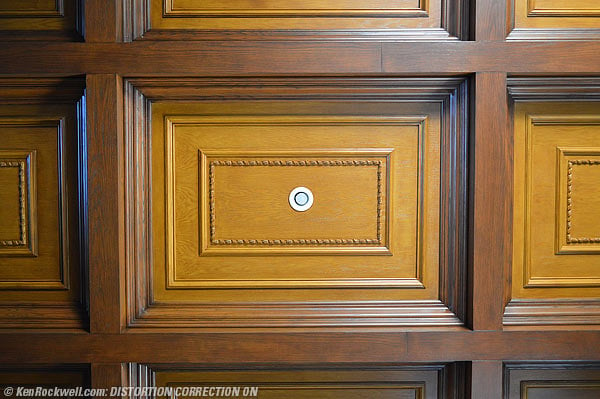
Image as shot with Distortion Correction ON. (for those of you without mice.)
Ergonomics
Nikon does a great job with its inexpensive DSLRs — better than it does with its professional cameras today!
Press the exposure compensation button and the rear LCD lights magically so you can see to set it before you bring the camera to your eye. The D3200 even highlights the value to make it obvious.
The PLAY button is still on the wrong side, demanding a second hand to hit PLAY.
On rare occasion, I've somehow hit the [Lv] (Live View) button by mistake, which can waste battery power and presents me with a perplexing black viewfinder until I realize what happened.
If I choose to set my Fn button to set white balance, I can't navigate down to the other info screen settings.
Setting Fn button to select image size and Quality is pointless because you've got only one dial. Therefore with this option, you have to spin past all the options, and usually will get something wrong. On bigger cameras, this option allows you to use two dials, one for size and one for quality, but with only one dial, forget it.
To set the Fn and other controls, these settings are all hiding in the menus under "buttons."
Mechanics
The D3200 is mostly plastic, with a metal lens mount and tripod socket.
This is perfect: it's light weight, and the durable parts are still metal.
Data
When formatted, cards are correctly titled "Nikon D3200."
SMALL BASIC JPG files (3,008 x 2,000 pixels), the way I shoot my D3200, have a median file size of 700 kB, and can be printed at any size. Depending on the subject, they'll range from 450kB to 1.1 MB.LARGE BASIC JPG files (6,016 x 4,000 pixels) have a median size of 2.6 MB, ranging from 2.0 to 3.2 MB.
Playback
Playback is fast and clear, as we expect from Nikon.
You can activate and deactivate many different playback screen options in the menus.
By default, there is a stupid 1940s slide-projector playback effect as yo swap to other images. I turned this off as soon as I got my D3200!
If you zoom-in with the YRGB histogram screen active, the histogram shows the values only for the area to which you've zoomed.
LCD
The D3200 has a superb LCD, more color-accurate than the LCDs of my D800, D800E and D4!
The D3200's LCD is big, bright, sharp and color-accurate. You couldn't really put a bigger screen on a camera this small.
The LCD is covered with uncoated clear plastic, not anti-reflection coated glass as is the better LCD of my Canon 5D Mark III.
I love the LCD of my D3200. IN fact, because it's more accurate and better looking than the LCD of my D800, D800E and D4, I prefer to shoot with my D3200! (I'm not very happy with the performance of the D800, D800E and D4; I greatly prefer my Canon 5D Mark III.)
Power and Battery
The USA MH-24 charger has a folding plug for travel.
The light blinks amber while charging, and solid when done.
Unlike fancier cameras, the battery gauge is only a 3-segment indicator that gives not that much warning when the battery gets low.
On my first charge, I got 500 shots when the meter first read 2/3, and at 577 shots it read 1/3.
I would expect getting more shots than this; I suspect I got as few as I did on my first charge because of al the menu playing I do with a new camera — and the two times the D3200 set itself to Live View accidentally.
Recommendations top
Intro Specs Performance Recommendations More
The Nikon D3200 is the camera I recommend to everyone who asks what camera to buy for great photos of family, friends, sports, concerts, theater and action.
Got kids and want great action, low-light and long-distance photos? The D3200 is the camera to get. Paying more won't get you much more other than a lot more weight to have to carry around.
Lenses top
The included 18-55mm VR is probably all you need for everything. If you're new to photography, the strongest advice I can give you from 45 years of experience is that its far more important to learn how to use what you've got, instead of confusing the issue by buying more lenses, as you're starting out.
If you need a telephoto lens for sports and theater, I use the 55-200mm VR. The 55-300mm VR zooms-in a little closer, but is bigger and more expensive. Either is excellent.
Personally, I usually use the 35mm f/1.8 DX for everything and leave the 18-55mm VR at home. I rarely use a zoom.
The 10-24mm DX is only if you need super wide-angles. (How to use Ultrawide Lenses.)
If you're counting every one of your 24 megapixels, you're most likely a computer hobbyist as opposed to a photographer, but if you are counting, the included 18-55mm lens isn't as sharp as the D3200 can be at 24 MP; you'll want the sharper 35mm f/1.8 DX instead.
See also the DX Dream Team.
Memory
I use only SanDisk or Lexar SD cards. Anything else is asking for trouble.
If you find all the time and expense I incur sharing all this information for free, this free website's biggest source of support is when you use these links, especially these to the D3200 with 18-55 VR from Adorama (also in red), from Amazon (also in red), when you get anything, regardless of the country in which you live.
Thank you!
Ken.
More Information top
Intro Specs Performance Recommendations More
© Ken Rockwell. All rights reserved. Tous droits réservés. Alle Rechte vorbehalten. Alla rättigheter förbehållna. Toate drepturile rezervate. Ken Rockwell® is a registered trademark.
Help Me Help You top
I support my growing family through this website, as crazy as it might seem.
The biggest help is when you use any of these links when you get anything. It costs you nothing, and is this site's, and thus my family's, biggest source of support. These places always have the best prices and service, which is why I've used them since before this website existed. I recommend them all personally.
If you find this page as helpful as a book you might have had to buy or a workshop you may have had to take, feel free to help me continue helping everyone.
If you've gotten your gear through one of my links or helped otherwise, you're family. It's great people like you who allow me to keep adding to this site full-time. Thanks!
If you haven't helped yet, please do, and consider helping me with a gift of $5.00.
As this page is copyrighted and formally registered, it is unlawful to make copies, especially in the form of printouts for personal use. If you wish to make a printout for personal use, you are granted one-time permission only if you PayPal me $5.00 per printout or part thereof. Thank you!
Thanks for reading!
Ken.
05 Nov 2022, July 2012
